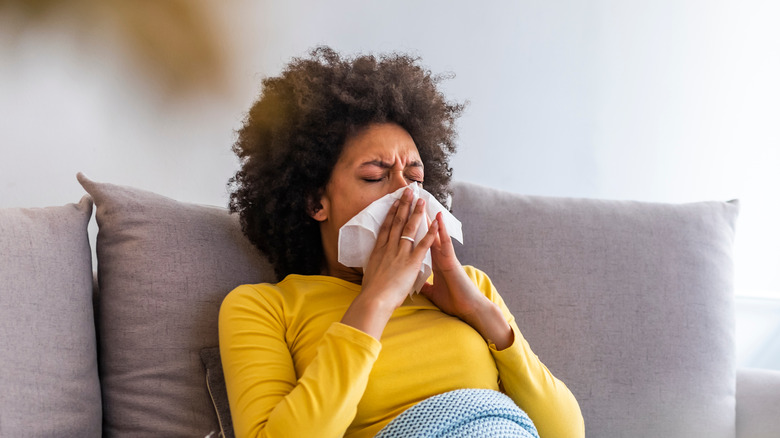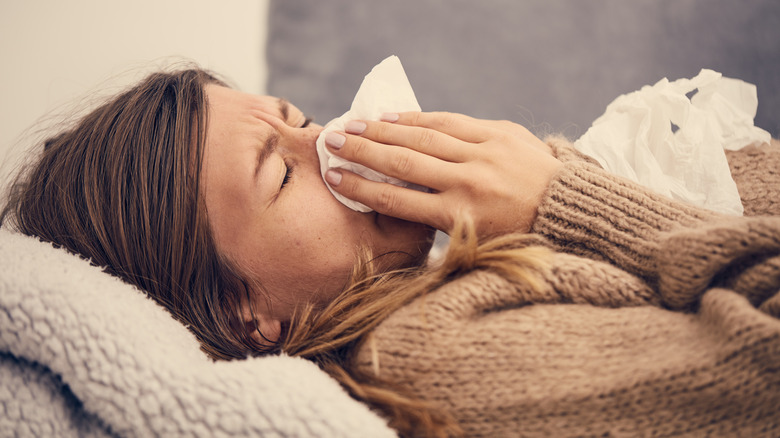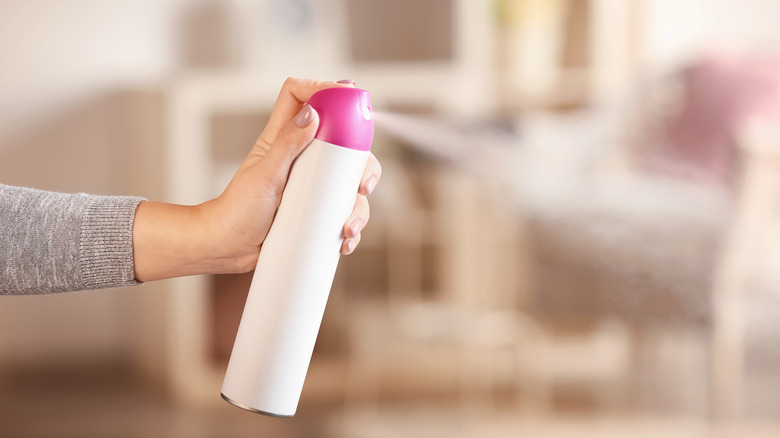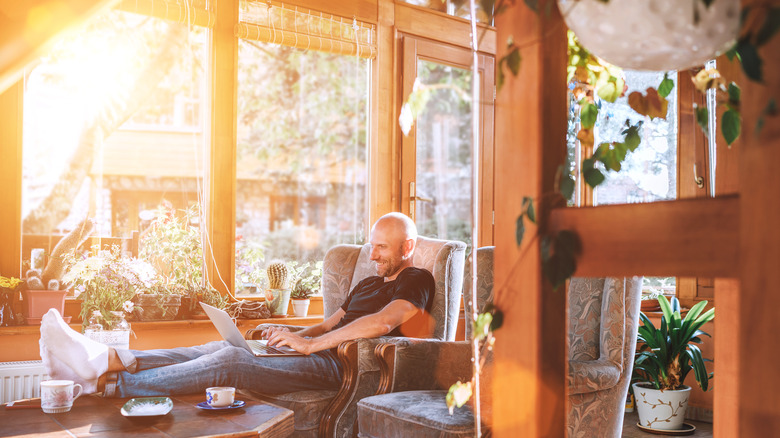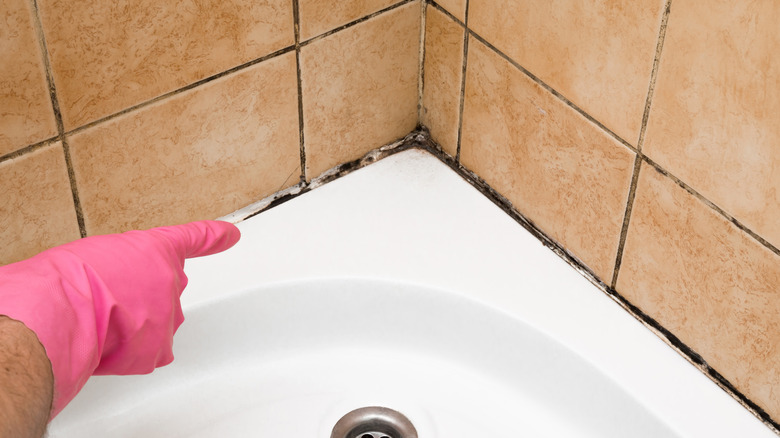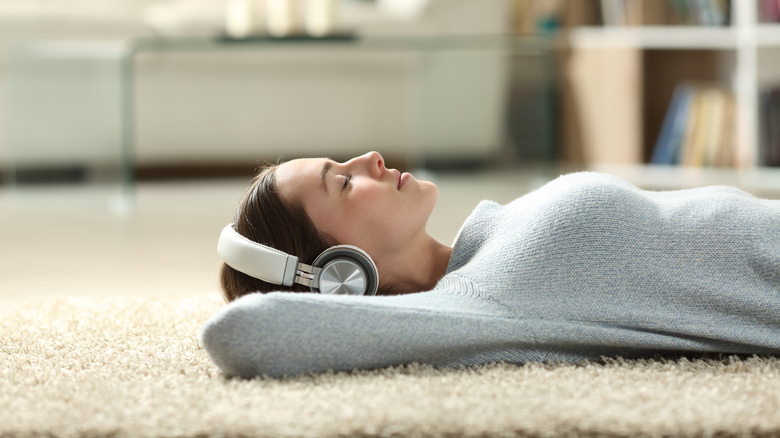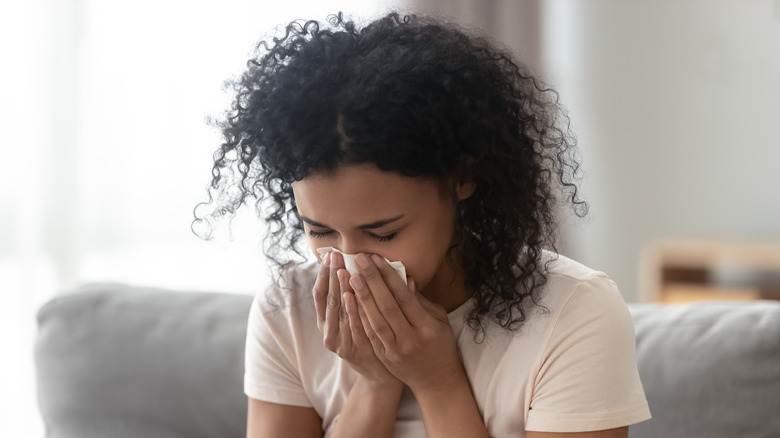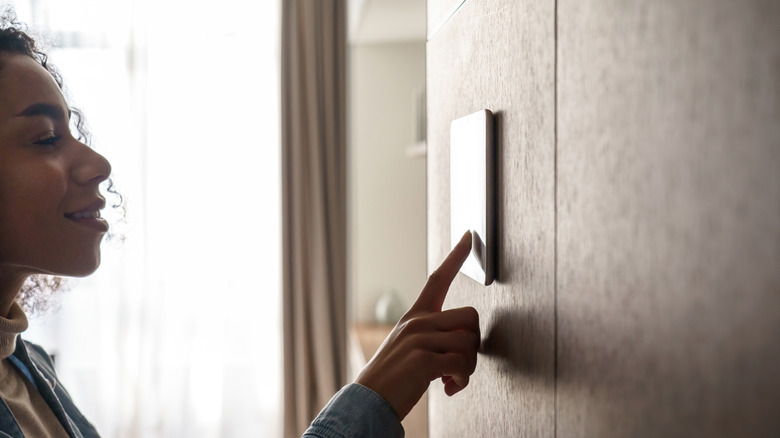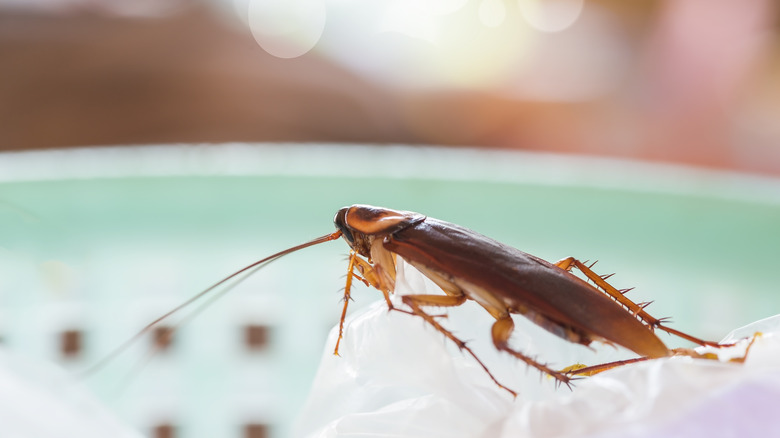Things In Your House That Are Making You Sneeze
A sneeze is one of life's true surprises. One of the body's natural expulsion mechanisms to rid our airways of irritants, sneezing can either feel like a release or a total annoyance (via Healthline). And for those with allergies, sneezing is a standard part of life. According to the Asthma and Allergy Foundation of America (AAFA), over 50 million Americans that experience a form of allergy every year — if you're one of them, you'll be well aware of how infuriating it can be to have a sneezing reaction triggered by something beyond your control.
And what if those triggers are in your very own home? For many people, sneezing due to allergenic stimuli peaks in the summer (with over 19 million adults experiencing hay fever each year, according to AAFA). Others may find themselves sneezing as soon as they walk through their front door, or as they're going through their everyday activities inside their home. Your house can be a hotbed for things that make you sneeze, and we've put together a list of some of the worst (and most fascinating) offenders. Grab your tissues and let's take a look!
Cinnamon-scented products could cause an allergic reaction
That cinnamon scent you bought around Thanksgiving might set the seasonal mood, but your nasal passage might not thank you for it. Cinnamon-scented products, according to Healthline, can contain cinnamyl alcohol or cinnamaldehyde, a substance found in cinnamon bark that contributes to the distinctive taste and smell of cinnamon (per Science Direct). These substances, when breathed in, can cause a mild allergenic reaction, leading you to sneeze.
However, while cinnamon scents usually provoke a small response, in more serious cases cinnamon and its components can trigger a severe allergic reaction and anaphylaxis, says Healthline. This kind of allergic response can restrict breathing and be potentially life-threatening. If you (or anyone else) experience symptoms of anaphylaxis — which include nausea, vomiting, trouble breathing, hives, and/or a rapid and weak pulse – seek medical attention immediately (via Mayo Clinic). If you notice that your cinnamon products are just making you a little sneezy, though, it can be helpful to switch to a different scent to see if you breathe a little easier, or to even avoid scented products entirely, as WebMD suggests.
Your bed is a haven to dust mites
Ah, your bed. Site of all that is comfy, restorative, and relaxing — and it could be the very thing that's making you sneeze fifty times a night. Your pillowcases, sheets, and mattress toppers can provide the ideal home for dust mites (per WebMD). These microscopic pests are one of the most common triggers for allergic reactions like sneezing around the home. According to the American Lung Association, they feed on your dead skin cells (ew, yes, we know), and in some cases can number in the hundreds of thousands.
For some, dust mites just cause sneezing or other mild symptoms like a runny nose; in more profound cases, they can cause chronic allergy symptoms, including persistent sneezing, congestion, or severe asthma attacks. To reduce the number of dust mites in your sheets, dust mite-proof covers are a handy way to keep these tiny nuisances at bay (per WebMD). You should also make sure you're changing your sheets weekly, and washing your old ones on a hot cycle and running them through a hot dryer afterward. It also helps to think about other fabrics in your bedroom where dust mites could settle, like curtains or even upholstered headboards, and consider if they can be cleaned or replaced. As dust mites feed on the moisture in the air, using a dehumidifier or making sure your room is free of sources of damp (like wet clothes or towels) can also help.
Your air freshener can carry potentially damaging chemicals
Wait a sec. Air fresheners are meant to make the air you breathe nicer, right? Well, unfortunately, some components of air fresheners can do just the opposite, and may cause you to sneeze or have other allergic reactions. According to allergists, air fresheners are super common triggers that most people don't suspect. "This is a much bigger problem than people realize," says Stanley Fineman, president-elect of the American College of Allergy, Asthma, and Immunology (ACAAI) in Boston, to Newswise. "About 20% of the population and 34% of people with asthma report health problems from air fresheners. We know air freshener fragrances can trigger allergy symptoms, aggravate existing allergies and worsen asthma."
These air fresheners, as well as scented candles, can cause these reactions thanks to volatile organic compounds (or VOCs), chemicals which are emitted as gas from scented products, according to the Environmental Protection Agency (EPA). In addition to irritating the airways, VOCs can cause damage to organs and the central nervous system, decrease the pollute air quality, and cause cancer, per the American Lung Association. VOCs are also released by a huge range of other man-made products like pesticides and paint strippers, as well as by burning wood. To avoid negative reactions, it's important to limit your use of products that release high levels of VOCs, and keep spaces well-ventilated when using them.
Your flowers can cause hay fever
The scent of fresh flowers in your home can be pure joy until you start sneezing up a storm. As anyone who has hay fever knows well, this can often be the result of the pollen released from flowers and other plants, prompting seasonal allergic rhinitis and various other symptoms, according to the Asthma and Allergy Foundation of America.
Even if you don't bring flowers into your home, you may also experience these symptoms if you're a keen gardener, as allergens can blow in through your window, especially in the spring, summer, and fall seasons. If you're particularly susceptible to hay fever, there are measures you can take to reduce flare-ups, primarily by making sure you're picking flowers and plants that are kinder to allergy sufferers. Flowers such as asters, daisies, dahlias, chrysanthemums, and sunflowers are bad choices for those with hay fever, according to The Spruce. On the flip side, if you want to select flowers or plants which produce little pollen, go for roses, daffodils, pansies, snapdragons, azaleas, or hibiscus, says WebMD. Lilies, irises, and tulips are also excellent options.
Your sunroom could be triggering a common reflex
Have you ever been enjoying the late afternoon light in your sunroom and been hit by a sudden sneezing fit? You're not alone, and it might not even be due to anything you're inhaling — you've simply got a strong photic sneeze reflex, according to Scientific American. Also known as the slightly less snappy "autosomal dominant compulsive helio-ophthalmic outbursts of sneezing" (abbreviated to ACHOO — fun, huh?) syndrome, the photic sneeze reflex can be triggered by light sources in general, but particularly by sunlight. It's estimated that between 18% and 35% of the population experience this reflex, which can be especially triggered by direct sunlight onto the face.
The photic sneeze reflex is a genetic trait, so if your parents do it, there's a strong likelihood you will too, states Healthline. The number of sneezes that are triggered varies from person to person, but are generally consistent every time, says Scientific American. There's no way to stop the photic sneeze reflex besides shielding your face from the sun and other bright lights. However, the reflex is completely harmless, although the sneezes can cause risk in certain situations, such as when you're driving.
In your bathroom, mold lurks
Mold is one of the most persistent houseguests you'll ever have, and aside from being deeply unsightly along your bathroom tiles, it could also be what's causing your sneezing. Mold releases spores that can cause an immune response upon breathing them in, according to the Mayo Clinic. Generally, the symptoms will be typical of many allergies, with a runny nose, itchy eyes, and sneezing. If you have asthma, however, mold can be more problematic and can result in the onset of an asthma attack.
Anyone who's ever tried to get rid of mold from a bathroom will know how annoying it is to fully erase. If you're tempted to use hardcore cleaning products to get rid of it, however, Anna Feldweg, attending physician at Brigham and Women's Hospital and clinical instructor of medicine at Harvard Medical School, recommends against them: "One [product] that has clearly been shown to be harmful to some people even when used as directed, is chlorine bleach and the various products made with it," she says to Everyday Health. "Aside from bleach, a variety of cleaning products contain very toxic chemicals, such as organic solvents," Feldweg adds. Instead, tackle your mold with white vinegar or baking soda for a natural clean, as The Spruce recommends.
Your carpets could be the culprit
So you've scoured every surface in your house, and you're still sneezing. What gives? If you've got carpets, maybe cast your eye slightly lower, as your plush pile can be a serious source of sneezes. These beds of fabric can host a range of nasal irritants such as dust and dust mites, mold, animal dander, and (sorry about this) invisible insect parts, according to Healthline. Even if you vacuum to high heaven, these allergens can still make themselves at home in your carpets. And what's more, in some cases, the very fiber, padding, or glue used to make the carpets can cause allergic reactions.
If you've got your eye on a bit of floor fabric, though, there are steps you can take to reduce its potential to stimulate allergies. Try to avoid wall-to-wall carpeting where possible, as AAFA recommends. But if that's not possible, avoid placing carpets in rooms like kitchens and bathrooms that are susceptible to damp, and therefore mold (per the American Lung Association). Opting for a low-pile carpet will also give allergens less space to settle, as the weave is shorter and tighter than a high-pile option. Finally, make sure you're vacuuming regularly.
Visitors to your home may bring unwanted things with them
We hate to ruin the party, but ... the visitors you just welcomed with open arms might be the reason you can't stop sneezing. The reason, though, is less due to their inherent allergy-producing qualities (hopefully), and more with what they might have brought into your house that wasn't there before (via Everyday Health). Beware especially of cat owners. "Cat allergens can be present at surprisingly high levels, even in homes that don't have cats," states Anna Feldweg, attending physician at Brigham and Women's Hospital and clinical instructor of medicine at Harvard Medical School, to Everyday Health. "This is because the allergen is so light that it travels through the air and can be carried indoors on the clothes of guests who have cats." For some people, cat dander can cause potentially serious allergenic responses, according to WebMD, so it's useful to be prepared. If you know a visitor might unintentionally bring dander or other allergens into your home, stock up on antihistamines or decongestant medication beforehand (via Mayo Clinic).
Vacuum cleaners can be triggers for sneezing
Here's the paradox. You vacuum to make your rooms and carpets cleaner and less irritating to your airways, and that very vacuum ... irritates your airways. What a life! Regrettably, this can be the case. As WebMD states, certain vacuum cleaners wind up spewing more dust, germs, and allergens into the air than they suck up. This can particularly be the case with older and/or less expensive vacuums. So if you're noticing that you sneeze every time you clean your carpet, it might be time to upgrade to a new vac. Getting a vacuum with a HEPA (high-efficiency particulate air) filter can be a good start, as these filters are designed to capture a high percentage of airborne particles that can potentially cause an allergenic response (per the EPA). Models containing these filters can be super pricey, though, so if you need to go for a cheaper option, make sure you're also cleaning your throw or floor rugs regularly, ideally washing them in hot water. It's important to remember, though, that vacuuming less probably isn't going to solve the problem: any vacuum worth its salt will still do a decent job at removing sneeze-culprits.
Your heating system might be causing you trouble
Summer's over. Hay fever retreats for another year. Everything's peaceful, with not a sneeze in sight ... until you turn your heating system on. "Sometimes when people turn their heat on in mid-to-late October, for the first week they find themselves coughing and sneezing," states Marjorie Slankard, associate clinical professor of medicine at Columbia Presbyterian Medical Center, to NBC News. Over the summer, your heating ducts steadily build up dust particles, mold, and other allergens, and when you crank up the heat, they're spewed out into your house in one go. As Slankard adds, "that's especially true if the heating ducts have not been cleaned for a while." To avoid this, it can be worth having your ducts cleaned shortly before you start using them for the season says Adrian Casillas, assistant professor of medicine for immunology and allergy at the University of California, Los Angeles, to NBC News. Casillas also recommends heading out for the day while the cleaning is underway, as the release of allergenic particles could cause mayhem for your airways. It's also important to regularly check your heating filtration system and to replace it if necessary.
Your trash can might have some unwanted visitors
Sorry in advance for this one. We don't often think of our trash cans as sites of allergic stimuli specifically, but they can be if you're allergic to cockroaches. Cockroaches carry a protein that can cause an allergic reaction, kicking your immune system into overdrive and producing sneezing and congestion among other symptoms, as AAFA advises. More worrying is when cockroach allergies interact with asthma to produce an asthma attack, which can be a particular problem for children. And these pests are right at home in your trash can, where they'll happily feed on anything in sight, according to pest removal company Terminix. Making sure you have a trash can with a tight lid, taking out the trash regularly, and cleaning the inside of your trash can are all ways to deter cockroaches from making a home inside. Cabinets and drawers, or behind toasters and fridges, can also be party central for roaches due to food debris, so make sure you keep all of these areas clean. And if you find that cleaning doesn't do the trick, seeking advice from a pest control service is a good move.
Hitting the home workout equipment? Here's why you're sneezing while you do
Find yourself sneezing during your home workout? It might be due to the exercise itself. What you could be experiencing is a bout of exercise-induced rhinitis, a pretty common medical condition that induces sneezing or nasal congestion when you work out, according to Verywell Health. This response is still fairly mysterious, and flies in the face of the typical bodily response to exercise — for most people, a workout can help ease a runny nose, sneezing, or other symptoms of congestion. What is known, however, is that exercise-induced rhinitis is common, regardless of whether you have an underlying allergy or not, as a study published in the Annals of Allergy, Asthma & Immunology shows. People with underlying allergies are more likely than those with no allergies to have this problem indoors — this is because you inhale more allergens during exercise due to heavier and more rapid breathing (via Verywell Health). But even people without allergies can still experience exercise rhinitis indoors. In those cases, it might be caused by odors, chemicals, or fumes in the home, or by high stress levels.
Your new furry friend may also be your foe
You've finally got the dog of your dreams. Your kids are ecstatic, the house feels complete, and you can't stop sneezing. Great. You may have a dog allergy on your hands — and contrary to popular belief, this isn't actually caused by the dog's hair, says WebMD. Instead, it's the dog's dander — flakes of dead skin — which causes the response, in addition to its urine or saliva. So, unfortunately, if your idea to combat your allergies is to get a short-haired dog over a long-haired one, it might not make that much difference.
You may already be aware you have a dog allergy, but if you're not sure, a skin or blood test with your doctor can determine for sure. One of the reasons why getting a test is a good idea is because dogs can often carry pollen or mold on their fur, which could be the real cause of your allergic response. If you've already bought your pup and it turns out you are allergic, there are still ways to mitigate the damage. Cleaning your home regularly, removing carpets to reduce the amount of dander, and keeping your dog out of your bedroom will all help.
Your nightcap might end your day with a sneeze
You've gotten to the end of the long day and avoided a sneezing fit. You made it! Then one sip of your nightly glass of wine, and boom. Sneeze city. Unfortunately, this could be due to a response to some of the substances used to make the vintage. Sulfites, a common food preservative frequently used in the wine industry, can be a culprit behind sneezing (per Healthline). "Those who suffer from sulfite intolerance experience symptoms similar to asthma and allergic rhinitis (sneezing, itchiness, blocked or runny nose)," states registered dietician Vanessa Rissetto to Bustle.
Remember, though, a response to sulfites doesn't necessarily indicate an allergy. "It's not an allergy, it's a reflex," says N. Franklin Adkinson, professor for Johns Hopkins Asthma and Allergy Center, to ABC News. So the good news is that it won't cause anaphylaxis in the worst-case scenario. It also may not be the sulfites making you sneezy. Histamines are also present in wine, particularly red wine, and could be causing your sneezing response — although as Tyler Colman, author of "Wine Politics: How Governments, Environmentalists, Mobsters and Critics Influence the Wines We Drink" says to ABC News, "even the levels in red wine aren't all that elevated."

